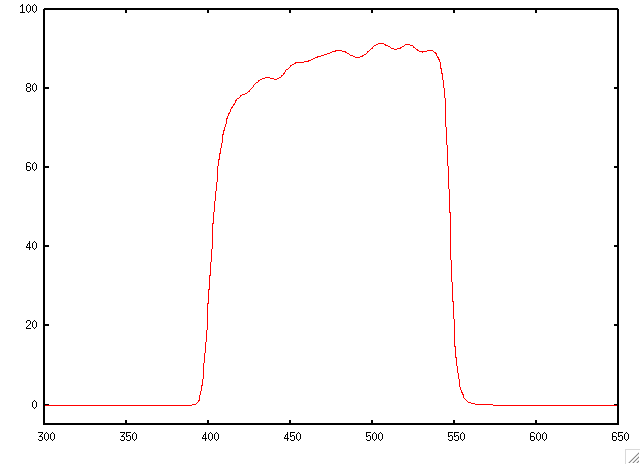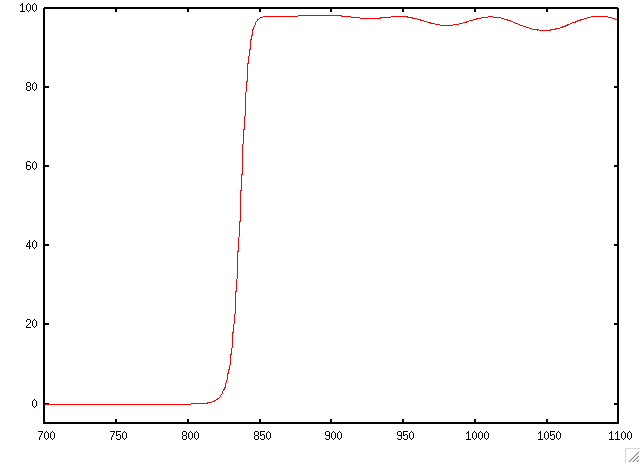KOOLS: Kyoto Okayama Optical Low-dispersion Spectrograph
Specifications
CCD
- CCD chip: SITe ST-002A, 2048 x 4096 pixels
- CCD QE(si001s)
- pixel size: 15μm
- pixel scale: 0."334/pix, 1mm = 22.27"
- Field of View: ∼ 5' x 4.4'
- gain: 2.25e/ADU
- overhead: 50 seconds for CCD wiping + 50 seconds for read-out (in a case of spectroscopy without binning)
CCD cosmetics (domeflat image, 2x2 binning):
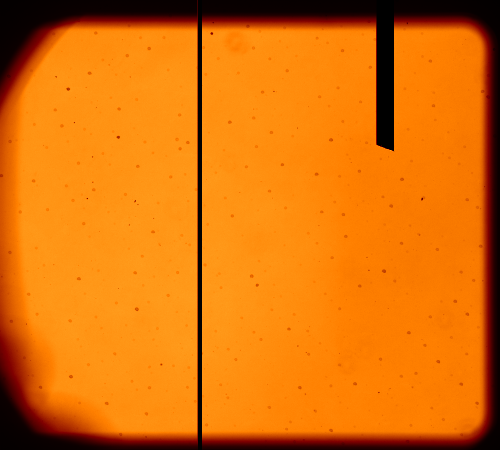
Grisms
[2009.10.21]
KOOLS has a long slit spectroscopy mode. Along with the normal operation, it also provides a "nod and shuffle" observing mode, which enables sky subtraction using the data taken at same CCD pixel as the object. For more details on the nod-and-shuffle mode in Japanese, please refer Dr. Hattori's page.
- grism No. 2: 6563AA blaze, 5700-8500AA, R=600-800(1."8slit)
- grism No. 5: 4400AA blaze, 4000-7400AA, R=400-600(1."8slit)
- VPH683: 1260lines/mm, 6830AA blaze, 6200-7200AA, R∼2000(1."0slit)
- VPH495: 1655lines/mm, 4960AA blaze, 4500-5400AA, R∼2000(1."0slit)
Wavelength coverage can be adjusted by moving the position of a slit. Please use Wavelength Coverage Calculator to find the approximate coverage of the grism and to know the wavelength region affected by CCD bad columns.
Three grisms can be installed at the same time. You need to specify which grism(s) you are going to use prior to the observation via Observation Checksheet.
Please also refer the sensitivity section.
Slits
[2009.02.13]
Following slits are available for spectroscopy, and three of them can be installed at the same time. You need to specify which slit(s) you are going to use prior to the observation via Observation Checksheet.
- 1.0" (0.164mm)
- 1.4" (0.230mm)
- 1.8" (0.297mm)
- 3.0" (0.492mm)
- wide (6")
(cf. 1mm = 6.09")
Filters
Kools has imaging mode with 5' x 4.4' field of view. There are B, V, R and I band filters used in OOPS, and newer filters including SDSS g' and z', as well as Rc and Ic filters. There are also some narrow-band filters such as designed to trace redshifted Hα, which were made for Kyoto 3D-I spectrograph. If you are interested in using narrow-band filters, please contact Dr. Iwata (iwata [at] oao.nao.ac.jp).
B, V, R, I (used in OOPS)
| band | center wavelength | FWHM | peak transmission |
|---|---|---|---|
| B | 4400A | 800A | 52% |
| V | 5450A | 1250A | 95% |
| R | 6400A | 1625A | 88% |
| I | 8000A | 1600A | 97% |
SDSS filters
[2008/03/04]
SDSS g' and z' filters are installed, and they will be tested during engineering time in near future.
Rc and Ic Filters
[2008/03/14]
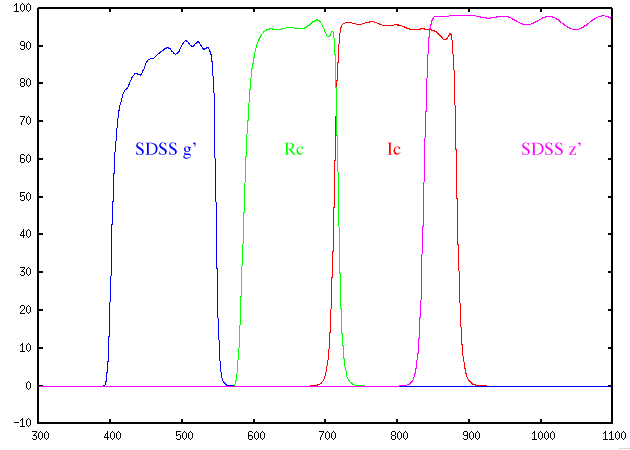
Sensitivities
[2010.03.18, 2010.09.03]
We provide a Spectroscopy Exposure Time Calculator for point sources. Observers who consider a submission of a proposal of point-source spectroscopy should refer the page. Note that the code is still in beta. If you encounter any problem or weird behavior, please contact ikuru.iwata [at] nao.ac.jp.
For S/N calculation of emission lines, I put a table of wavelength sampling after 2 pixel binning:
| Grism | Sampling(Å/pix) for 2 bin |
|---|---|
| VPH495 | 1.78 |
| VPH683 | 2.24 |
| No. 5 | 4.88 |
| No. 2 | 3.78 |
We are sorry but imaging sensitivity has not been determined yet. Please contact ikuru.iwata [at] nao.ac.jp if you want to know the feasibility of imaging observations.
The tables below are based on test observations 2007/03/20, 2007/08/09-2007/08/11 and 2008/03/07.
Point source, No.2 grism, 1.8" slit, 1,200sec / 1,800sec exposure, 2x2 binning
[2008.03.07, updated on 2008.08.16, 2009.04.14]
Note: Weather condition was not best during these exposures (hazy).
| 1,200sec exposure | 1,800sec exposure | |||
|---|---|---|---|---|
| wavelength | 1sigma (erg/s/cm2/AA) | 5sigma (AB mag) | 1sigma (erg/s/cm2/AA) | 5sigma (AB mag) |
| 5,500 | 8.0e-17 | 17.4 | 6.0e-17 | 17.7 |
| 6,000 | 7.0e-17 | 17.3 | 5.5e-17 | 17.6 |
| 6,500 | 5.0e-17 | 17.5 | 3.5e-17 | 17.9 |
| 7,000 | 5.0e-17 | 17.4 | 4.0e-17 | 17.6 |
| 7,500 | 6.0e-17 | 17.0 | 5.0e-17 | 17.2 |
| 8,000 | 9.0e-17 | 16.4 | 7.5e-17 | 16.6 |
| 8,500 | 1.7e-16 | 15.6 | 1.5e-16 | 15.8 |
Point source, No.5 grism, 1" slit, 1,200sec exposure, 2x2 binning
[2007.08.10]
| wavelength | 1sigma (erg/s/cm2/AA) | 5sigma (AB mag) |
|---|---|---|
| 4,000 | 1.5e-16 | 17.4 |
| 5,000 | 8.0e-17 | 17.6 |
| 6,000 | 1.8e-16 | 16.3 |
| 7,000 | 1.8e-16 | 16.0 |
Point source, VPH495 grism, 1.8" slit, 1,200sec exposure, 2x2 binning
[2008.08.16] (based on the data taken on 2007/12/09)
| wavelength | 1sigma (erg/s/cm2/AA) | 5sigma (AB mag) |
|---|---|---|
| 4,400 | 2.5e-16 | 16.6 |
| 4,600 | 1.0e-16 | 17.5 |
| 4,800 | 5.0e-17 | 18.2 |
| 5,000 | 4.0e-17 | 18.4 |
| 5,200 | 6.0e-17 | 17.8 |
| 5,400 | 1.0e-16 | 17.2 |
| 5,600 | 4.0e-16 | 15.6 |
Point source, VPH683 grism, 1" slit, 1,200sec exposure, 2x2 binning
[2008.08.13] (based on the data taken on 2007/03/20)
| wavelength | 1sigma (erg/s/cm2/AA) | 5sigma (AB mag) |
|---|---|---|
| 6,200 | 2.5e-16 | 15.9 |
| 6,500 | 7.5e-17 | 17.1 |
| 6,800 | 7.0e-17 | 17.1 |
| 7,000 | 8.0e-17 | 16.9 |
| 7,200 | 1.0e-16 | 16.6 |
| 7,400 | 3.0e-16 | 15.3 |
1,200sec point source limits
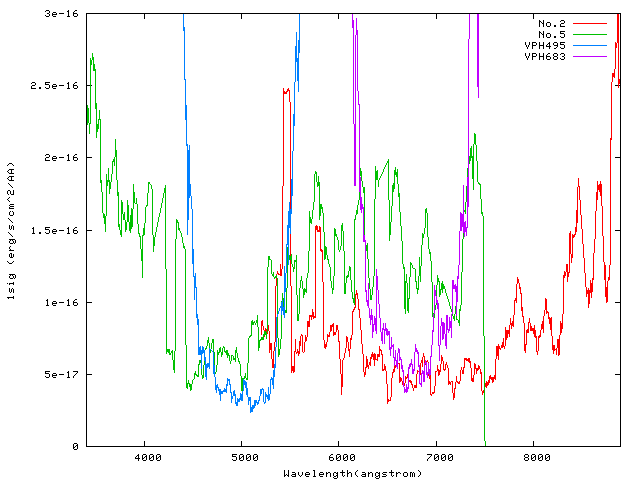
Limiting magnitude for extended sources, No.5 grism
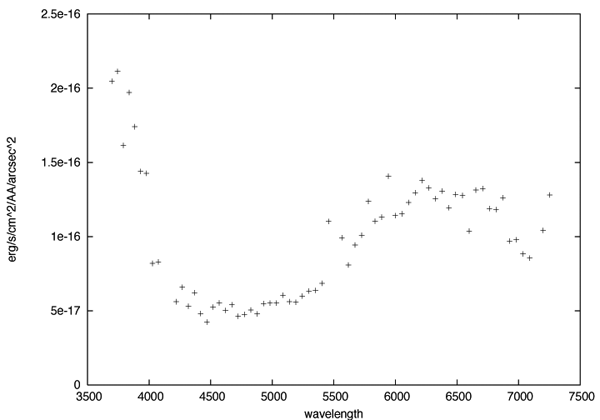
At 5,000AA this corresponds to the 5-sigma surface brightness limit of 19.9AB mag/arcsec2 with a 1,200 sec exposure.
More detailed description for observations on 2007/08 in Japanese: 日本語でのより詳しい説明
Note: AB mag to Vega mag conversion
| Band (λ) | AB - Vega |
|---|---|
| B (4400) | -0.1 |
| V (5500) | 0.0 |
| R (6500) | 0.2 |
| I (8000) | 0.5 |
Overheads
Here we summarize typical overheads.
Overheads required for each target pointing:
- Telescope pointing: 5 minutes
- Field identification, object position adjustment and guide acquisition: 15 minutes
Overheads required for each exposure:
- readout: 40 seconds (for 2x2 binning), 2.5 minutes (without binning)
- telescope nodding (if required:) 3 minutes
- taking HCT (if required:) 3 minutes
